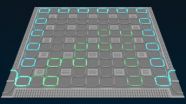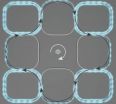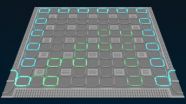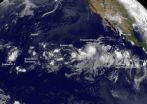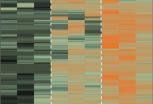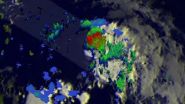(Press-News.org) Topological transport of light is the photonic analog of topological electron flow in certain semiconductors. In the electron case, the current flows around the edge of the material but not through the bulk. It is "topological" in that even if electrons encounter impurities in the material the electrons will continue to flow without losing energy.
In the photonic equivalent, light flows not through and around a regular material but in a meta-material consisting of an array of tiny glass loops fabricated on a silicon substrate. If the loops are engineered just right, the topological feature appears: light sent into the array easily circulates around the edge with very little energy loss (even if some of the loops aren't working) while light taking an interior route suffers loss.
Mohammad Hafezi and his colleagues at the Joint Quantum Institute have published a series of papers on the subject of topological light. The first pointed out the potential application of robustness in delay lines and conceived a scheme to implement quantum Hall models in arrays of photonic loops. In photonics, signals sometimes need to be delayed, usually by sending light into a kilometers-long loop of optical fiber. In an on-chip scheme, such delays could be accomplished on the microscale; this is in addition to the energy-loss reduction made possible by topological robustness (1).
The next paper reported on results from an actual experiment. Since the tiny loops aren't perfect, they do allow a bit of light to escape vertically out of the plane of the array (2). This faint light allowed the JQI experimenters to image the course of light. This confirmed the plan that light persists when it goes around the edge of the array but suffers energy loss when traveling through the bulk.
The third paper, appearing now in Physical Review Letters, actually delivers detailed measurements of the transmission (how much energy is lost) and delay for edge-state light and for bulk-route light (3). The paper is notable enough to have received an "editor's suggestion" designation. "Apart from the potential photonic-chip applications of this scheme," said Hafezi, "this photonic platform could allow us to investigate fundamental quantum transport properties."
Another measured quality is consistency. Sunil Mittal, a graduate student at the University of Maryland and first author on the paper, points out that microchip manufacturing is not a perfect process. "Irregularities in integrated photonic device fabrication usually result in device-to-device performance variations," he said. And this usually undercuts the microchip performance. But with topological protection (photons traveling at the edge of the array are practically invulnerable to impurities) at work, consistency is greatly strengthened.
Indeed, the authors, reporting trials with numerous array samples, reveal that for light taking the bulk (interior) route in the array, the delay and transmission of light can vary a lot, whereas for light making the edge route, the amount of energy loss is regularly less and the time delay for signals more consistent. Robustness and consistency are vital if you want to integrate such arrays into photonic schemes for processing quantum information.
How does the topological property emerge at the microscopic level? First, look at the electron topological behavior, which is an offshoot of the quantum Hall effect. Electrons, under the influence of an applied magnetic field can execute tiny cyclonic orbits. In some materials, called topological insulators, no external magnetic field is needed since the necessary field is supplied by spin-orbit interactions---that is, the coupling between the orbital motion of electrons and their spins. In these materials the conduction regime is topological: the material is conductive around the edge but is an insulator in the interior.
And now for the photonic equivalent. Light waves do not usually feel magnetic fields, and if they do it is very weak. In the photonic case, the equivalent of a magnetic field is supplied by a subtle phase shift imposed on the light as it circulates around the loops. Actually the loops in the array are of two kinds: resonator loops designed to exactly accommodate light at a certain frequency, allowing the waves to circle the loop many times. Link loops, by contrast, are not exactly suited to the waves, and are designed chiefly to pass the light onto the neighboring resonator loop.
Light that circulates around one unit cell of the loop array will undergo a slight phase change, an amount signified by the letter phi. That is, the light signal, in coming around the unit cell, re-arrives where it started advanced or retarded just a bit from its original condition. Just this amount of change imparts the topological robustness to the global transmission of the light in the array.
In summary, documented on-chip light delay and a robust, consistent, low-loss transport of light has now been demonstrated. The transport of light is tunable to a range of frequencies and the chip can be manufactured using standard micro-fabrications techniques.
INFORMATION:
1. Concept for making on-chip delay lines: http://jqi.umd.edu/news/miniaturizing-delay-lines
2. Topological light observed in 2D arrays: http://jqi.umd.edu/news/topological-light
3. "Topologically Robust Transport of Photons in a Synthetic Gauge Field," S. Mittal, J. Fan, S. Faez, A. Migdall, J. M. Taylor, and M. Hafezi, Physical Review Letters, to be published in August 2014; archive version: http://arxiv.org/pdf/1404.0090v1.pdf
Mohammad Hafezi, Hafezi@umd.edu; Sunil Mittal, mittals@umd.edu
Press contact at JQI: Phillip F. Schewe, pschewe@umd.edu, 301-405-0989. http://jqi.umd.edu/
On-chip topological light
First measurements of transmission and delay
2014-08-01
ELSE PRESS RELEASES FROM THIS DATE:
Expressive writing may help breast cancer survivors
2014-08-01
Writing down fears, emotions and the benefits of a cancer diagnosis may improve health outcomes for Asian-American breast cancer survivors, according to a study conducted by a researcher at the University of Houston (UH).
"The key to developing an expressive writing intervention is the writing instruction. Otherwise, writing is just like a journal recording facts and events. Writing a journal can be therapeutic, but oftentimes we don't get the empirical evidence to determine whether it's effective or not," said Qian Lu, assistant professor and director of the Culture ...
Mapping the optimal route between two quantum states
2014-08-01
As a quantum state collapses from a quantum superposition to a classical state or a different superposition, it will follow a path known as a quantum trajectory. For each start and end state there is an optimal or "most likely" path, but it is not as easy to predict the path or track it experimentally as a straight-line between two points would be in our everyday, classical world.
In a new paper featured on the July 30 cover of Nature, scientists from the Institute for Quantum Studies at Chapman University, the University of Rochester, University of California at Berkeley, ...
Cordilleran terrane collage
2014-08-01
Boulder, Colo., USA - In the August 2014 issue of LITHOSPHERE, Steve Israel of the Yukon Geological Survey and colleagues provide conclusions regarding the North American Cordillera that they say "are provocative in that they blur the definition of tectonic terranes, showing that many observations of early geologists can be attributed to evolving geologic processes rather than disparate geologic histories."
Western North America is characterized by the Cordilleran accretionary mountain belt, which has seen episodic plate convergence since the early Paleozoic, about 253 ...
On-chipt topological light
2014-08-01
Topological transport of light is the photonic analog of topological electron flow in certain semiconductors. In the electron case, the current flows around the edge of the material but not through the bulk. It is "topological" in that even if electrons encounter impurities in the material the electrons will continue to flow without losing energy.
In the photonic equivalent, light flows not through and around a regular material but in a meta-material consisting of an array of tiny glass loops fabricated on a silicon substrate. If the loops are engineered just right, ...
Society bloomed with gentler personalities and more feminine faces
2014-08-01
DURHAM, N.C. -- Modern humans appear in the fossil record about 200,000 years ago, but it was only about 50,000 years ago that making art and advanced tools became widespread.
A new study appearing Aug. 1 in the journal Current Anthropology finds that human skulls changed in ways that indicate a lowering of testosterone levels at around the same time that culture was blossoming.
"The modern human behaviors of technological innovation, making art and rapid cultural exchange probably came at the same time that we developed a more cooperative temperament," said lead author ...
History of culture visualized through art history, physics, complexity
2014-08-01
Coral Gables, Fla. (July 31, 2014) -- Quantifying and transforming the history of culture into visual representation isn't easy. There are thousands of individual stories, across thousands of years, to consider, and some historical conditions are nearly impossible to measure.
Addressing this challenge, Dr. Maximilian Schich, associate professor of arts and technology at The University of Texas at Dallas, brought together a team of network and complexity scientists, including University of Miami physicist Chaoming Song, to create and quantify a big picture of European ...
'Normal' bacteria vital for keeping intestinal lining intact
2014-08-01
August 1, 2014 — (BRONX, NY) — Scientists at Albert Einstein College of Medicine of Yeshiva University have found that bacteria that aid in digestion help keep the intestinal lining intact. The findings, reported online in the journal Immunity, could yield new therapies for inflammatory bowel disease (IBD) and a wide range of other disorders.
The research involved the intestinal microbiome, which contains some 100 trillion bacteria. The role of these microorganisms in promoting or preventing disease is a major emerging field of study. Einstein scientists found that absorption ...
A train of 5 tropical cyclones in the Central and Eastern Pacific
2014-08-01
A train of developing tropical low pressure areas stretch from the Eastern Pacific Ocean into the Central Pacific and they were captured in an image from NOAA's GOES-West satellite on August 1. The train of five tropical lows include the remnants of Tropical Storm Genevieve and newly developed Tropical Storm Iselle.
NOAA's GOES-West satellite captured an image of the Pacific Ocean on August 1 at 1200 UTC (8 a.m. EDT) that showed post-tropical cyclone Genevieve's remnants between three other systems. The GOES-West image shows the train of storms with a well-developed Iselle ...
A map for eye disease
2014-08-01
Understanding eye diseases is tricky enough. Knowing what causes them at the molecular level is even more confounding.
Now, University of Iowa researchers have created the most detailed map to date of a region of the human eye long associated with blinding diseases, such as age-related macular degeneration. The high-resolution molecular map catalogs thousands of proteins in the choroid, which supplies blood and oxygen to the outer retina, itself critical in vision. By seeing differences in the abundance of proteins in different areas of the choroid, the researchers can ...
NASA finds heavy rainfall and wind shear in newborn Tropical Storm Bertha
2014-08-01
VIDEO:
This 3-D flyby of Tropical Storm Bertha on Aug. 1 was created from TRMM satellite data. It shows (from the south) intense thunderstorms were reaching heights of over 15km (about...
Click here for more information.
The Tropical Rainfall Measuring Mission satellite known as TRMM found rain was falling heavily in the Atlantic Ocean's second tropical storm of the hurricane season. Bertha was close to the Lesser Antilles, prompting warnings and watches.
The National Hurricane ...
LAST 30 PRESS RELEASES:
Numbers in our sights affect how we perceive space
SIMJ announces global collaborative book project in commemoration of its 75th anniversary
Air pollution exposure and birth weight
Obstructive sleep apnea risk and mental health conditions among older adults
How talking slows eye movements behind the wheel
The Ceramic Society of Japan’s Oxoate Ceramics Research Association launches new international book project
Heart-brain connection: international study reveals the role of the vagus nerve in keeping the heart young
Researchers identify Rb1 as a predictive biomarker for a new therapeutic strategy in some breast cancers
Survey reveals ethical gaps slowing AI adoption in pediatric surgery
Stimulant ADHD medications work differently than thought
AI overestimates how smart people are, according to HSE economists
HSE researchers create genome-wide map of quadruplexes
Scientists boost cell "powerhouses" to burn more calories
Automatic label checking: The missing step in making reliable medical AI
Low daily alcohol intake linked to 50% heightened mouth cancer risk in India
American Meteorological Society announces Rick Spinrad as 2026 President-Elect
Biomass-based carbon capture spotlighted in newly released global climate webinar recording
Illuminating invisible nano pollutants: advanced bioimaging tracks the full journey of emerging nanoscale contaminants in living systems
How does age affect recovery from spinal cord injury?
Novel AI tool offers prognosis for patients with head and neck cancer
Fathers’ microplastic exposure tied to their children’s metabolic problems
Research validates laboratory model for studying high-grade serous ovarian cancer
SIR 2026 delivers transformative breakthroughs in minimally invasive medicine to improve patient care
Stem Cell Reports most downloaded papers of 2025 highlight the breadth and impact of stem cell research
Oxford-led study estimates NHS spends around 3% of its primary and secondary care budget on the health impacts of heat and cold in England
A researcher’s long quest leads to a smart composite breakthrough
Urban wild bees act as “microbial sensors” of city health.
New study finds where you live affects recovery after a hip fracture
Forecasting the impact of fully automated vehicle adoption on US road traffic injuries
Alcohol-related hospitalizations from 2016 to 2022
[Press-News.org] On-chip topological lightFirst measurements of transmission and delay
